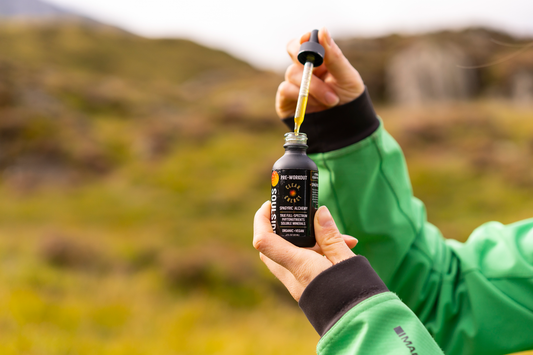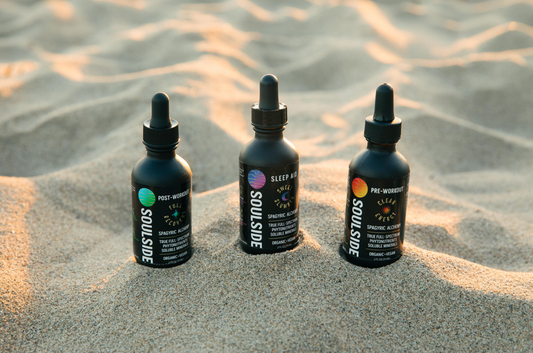Health is complicated, intricate, personal and ever-evolving. A host of complex and interconnected factors make up the picture of your wellness in any given moment.
It can feel overwhelming to navigate the world of wellness and strive for optimal health when the cascade of information and products to help you meet your health goals feels never ending. But it doesn’t have to be so overwhelming and complicated. In fact, often we skip over the foundational pillars of health that are so essential to vibrant living.
So let’s refocus on getting back to the basics.
This article will help you explore the six foundational pillars of health to reorient how you create energy, vitality and wellbeing in your life.

You want to feel well.
Like everyone, you want to feel well. You hope to have an abundance of energy, peace of mind and a strong body. You want to experience the absence of symptoms, so that you can do all of the things that you love without feeling held back by your body. The problem is that perhaps you don’t actually feel very well, as so many people experience in modern times.
Even as medicine advances at a remarkable rate, we seem to be living in a more and more unwell world. That is because we are missing an important link: building the foundations and basics of health.
There are elements to a healthy lifestyle that are profound and universal.
They are even simple in nature, though they will take effort and commitment to integrate into your life.
Focus on the Foundations of Health
In a world inundated with information about how to live a healthy, energetic and symptom-free life, it can feel disorienting and even impossible to navigate the landscape of shiny new products and health fads to find your way to personal health and freedom. My proposal: focus on the foundations.
You are the architect and creator of your own life and there are an abundance of practices and habits that you can integrate to build strong and long-lasting health.
When you build foundational wellness from within, you build a house of health that lasts and you learn the landscape of your particular needs and desires related to health. As you journey through learning the Six Pillars of Health - Nourishment, Movement, Wind Down, Protection, Connection and Purpose - remember that while there are universal truths to health, you get to decide how you implement those habits in your unique life.
One Change at a Time
As you learn the six pillars of health, note where you can take small actions to improve resilience and functioning in each of the areas. Remember that true, lifelong health is built over time, so it is more effective to start small and stay committed, rather than get overwhelmed by a volume of change that isn’t truly achievable.
Choose one or two areas of improvement to focus on and when those habits feel integrated, focus on the next area. Health is a lifelong journey, so don’t get discouraged if you feel far away from your goals; every meaningful change you incorporate makes a difference.
There is Hope!
Perhaps the most powerful aspect of focusing on the foundations of health is the incredible hope and potential you can cultivate. It is possible to feel more and more abundant in your body as you personalize your health journey and build the self-confidence to nourish your own system, rather than relying on outside sources. Every positive action begets another positive action, so begin where it feels right and transform your health from there.
Pillar One: Nourishment
Nourishment embodies the concept of food as medicine and that what we put into our system has the ability to heal or to hurt. Wendell Berry wrote, “People are fed by the food industry, which pays no attention to health, and are treated by the health industry, which pays no attention to food.” You can break this patterning; food is powerful medicine, so start to treat it as such.
At the most basic level, Nourishment is about eating real, whole foods – foods that don’t need an ingredient list. Feed your body with a variety of amazing foods that come from the earth. You want to eat all the colors of the rainbow, and consume food that isn’t contaminated with pesticides and other chemicals.
Try This: In Frank Lipman, MD’s book How to Be Well, he describes “The Perfect Plate”: 50-70% non-starchy veggies, 10-15% best quality protein and 20-30% healthy fat. Rather than framing Nourishment as a type of restriction, try creating “The Perfect Plate”. It works because when you add in a variety and volume of high quality, health-promoting foods, you “crowd out” the foods that can disrupt your health goals.
It can be important to remove foods that are toxic to your body – foods that you are allergic or sensitive to, are full of chemicals that are difficult for your body to digest properly and foods with ingredients that you don’t recognize.
Finally, Nourishment includes how you eat: you want to eat mindfully, so that your body is in “rest and digest” mode and can absorb all the amazing nutrients you are putting in. Try eating with people who make you smile and being kind and graceful to yourself when you eat something that doesn’t feel good. Take the time to truly enjoy your food – experiment with flavors, practice gratitude for the food on your plate, cook with loved ones and slow down when you eat.
Pillar Two: Movement
Movement refers to how you exercise and move your body. Importantly, this pillar is not about desperately burning calories and sculpting the perfect physique per se, but rather about integrating movement into your daily life in a way that is sustainable, fun and allows you to have a strong and capable body to carry you through life.
It is time to reframe the concept of working out “from being a chore to a practice” (Dr. Lipman, How to Be Well). Learn what kind of movement excites you and authentically feels good in your body, rather than drains you or leaves you so uninspired it is difficult to show up next time. Developing a consistent movement practice allows you to be more authentic in your exercise endeavor and reclaim it as part of your life, rather than something to achieve or as a means to an ideal that is inauthentic to your true happiness.
Try This: Look for activities that feel genuinely fun and where you are encouraged to honor your body’s boundaries, explore what you need on any given day, where you like the trainer and/or the community and it feels exciting to show up. Aim for energy, strength, vitality, community, play and strategic/mindful rest, rather than exhaustion, burnout and striving for goals shaped by outside forces or an ideal of yourself from younger years.
Movement can also refer to getting outside and enjoying nature; walking, surfing or a bike ride with a friend are all beautiful forms of movement.
There are innumerable ways to move your body; start thinking of movement as a practice and include daily movement that feels authentic to you, your needs and desires.
Pillar Three: Wind Down
Wind Down is about stress management, sleep and relaxation. In a culture that highly values busyness and achieving, it has become difficult to sign off and find stillness, relaxation and peace. But we must. When we are “on” all day, everyday, our nervous systems take a toll and the elevated stress response impacts every area of health in the body.
Stress management comes in many shapes and forms – yoga, counseling, breathing, mindfulness, saying “no”, doing more things that bring you joy, learning self-soothing skills, working less and playing more, eating food that nourishes you, having sex, talking to a friend, and on and on. Learning to wind down is about learning what works for you.
Try This: Most of us have a gut feeling about an action we could take to reduce stress in our lives; start there. If you’ve been thinking about therapy, try looking up some local professionals or if you have wondered about mindfulness, download Headspace and give it a try.
Don’t Forget Sleep
Sleep is one of the building blocks of health; it is essential for all of our biological processes, stable mental health and is when an incredible amount of repair in the body occurs. If you aren’t sleeping well, you are going to have a really hard time achieving your health goals.
So if you know that sleep isn’t optimal, take the time to create healthy habits around it; turn off screens before bed, go to sleep when you are tired, sleep in a dark and cool room, cut the alcohol, try taking a bath before bedtime or doing a restorative yoga class.
Pillar Four: Protection
Protection is about managing the toxic load of modern life. Unfortunately, we currently live in a pretty toxic world. From BPA in plastic to endocrine disruptors in our skincare products to nasty chemicals in our house cleaners, carcinogens in our tap water, glyphosate in our veggies - eek! It is a little scary when you go down the toxicity rabbit hole.
But don’t fear. There is a lot you can do to mitigate the impact of modern life and it is getting easier as clean products become more mainstream and effective. The truth is that we can’t escape all of the exposure we have on a day to day basis to toxins. However, there is a ton that you can do to minimize the exposure and effects of all this toxicity and it is important to do so.
Start Here: Begin with educating yourself. Remember that there are powerful financial forces keeping our shelves stocked with foods and products that aren’t necessarily safe, but you have the power to learn about their impact and make one meaningful change at a time. Buy organic produce, start using a water filter, and trade out conventional skin products for non-toxic ones as they run out.
Pillar Five: Connection
This pillar refers to your connection with yourself, with others (community) and the natural world around you. A sense of belonging in relationships with a few important people who know you in combination with trust in your relationship with your own internal emotional landscape are crucial to wellbeing and harmony.
One could argue that this is the most important pillar. You must develop a deep connection with yourself in order to be able to know what feels good in your body, what your heart really desires, what your values are, how you genuinely want to live your life and with whom you want to spend your time. Stress will continue forever if you are living out of alignment, but you need to know what your most aligned self looks like in order to follow that path.
Connection is a practice. Learning it can come through therapy, yoga, spiritual guidance, or through meditation, journaling, mindfulness and breathing (among many other avenues).
We experience connection when we hug another human, practice gratitude, commit random acts of kindness and put our bare feet on the earth or sit in the sun and listen to the wind. Connection often requires a sense of slowing down and intentionality, which can feel near impossible at the current pace of life. So start small - carve out a five minute journaling session or try two weeks of daily mindfulness.
Pillar Six: Purpose
Purpose is about finding and following your passions, nurturing what really lights you up, and engaging with your dharma – your unique talents and gifts to offer to others. Purpose will naturally grow from a Connection practice and is often an offshoot of developing a spiritual life.
Think about: What excites you? What unique gifts do you have? What makes you light up? What gives you that sense of ‘flow’? What do you do purely for fun? How do your gifts help others? How can your unique talents and gifts be of service to the world?
Most importantly, do the rituals and behaviors that support your purpose, even if it is on the smallest scale.
When in doubt, get back to basics
Much of your wellbeing is within your own control and though health is incredibly complicated, it pays to remember that it can simultaneously be simple.. We can overwhelm ourselves searching for answers without first checking in to make sure that we are sleeping well, drinking enough water, talking to friends and eating veggies.
Taking the time and effort to build resilience and strength within these six pillars not only will produce meaningful progress in how you feel, but will arm you with the tools to look within and know what your body needs to be able to respond to the circumstances of your own body and life.
With these tools, you have the opportunity to build self-mastery and self-trust to create vibrant wellbeing that is personalized to you.














